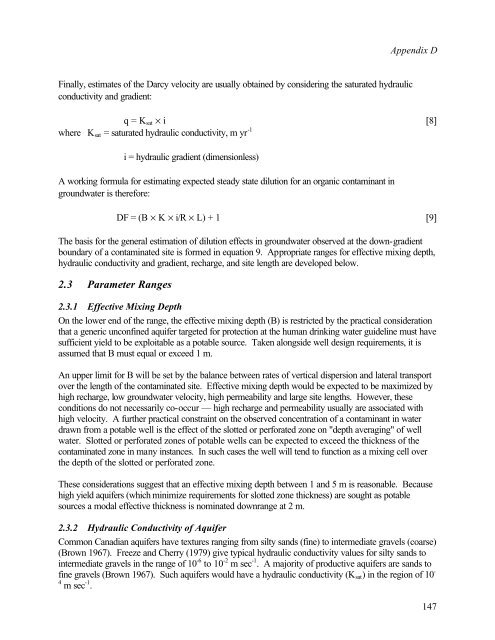Protocol for the Derivation of Environmental and Human ... - CCME
Protocol for the Derivation of Environmental and Human ... - CCME
Protocol for the Derivation of Environmental and Human ... - CCME
Create successful ePaper yourself
Turn your PDF publications into a flip-book with our unique Google optimized e-Paper software.
Appendix D<br />
Finally, estimates <strong>of</strong> <strong>the</strong> Darcy velocity are usually obtained by considering <strong>the</strong> saturated hydraulic<br />
conductivity <strong>and</strong> gradient:<br />
q = K sat × i [8]<br />
where K sat = saturated hydraulic conductivity, m yr -1<br />
i = hydraulic gradient (dimensionless)<br />
A working <strong>for</strong>mula <strong>for</strong> estimating expected steady state dilution <strong>for</strong> an organic contaminant in<br />
groundwater is <strong>the</strong>re<strong>for</strong>e:<br />
DF = (B × K × i/R × L) + 1 [9]<br />
The basis <strong>for</strong> <strong>the</strong> general estimation <strong>of</strong> dilution effects in groundwater observed at <strong>the</strong> down-gradient<br />
boundary <strong>of</strong> a contaminated site is <strong>for</strong>med in equation 9. Appropriate ranges <strong>for</strong> effective mixing depth,<br />
hydraulic conductivity <strong>and</strong> gradient, recharge, <strong>and</strong> site length are developed below.<br />
2.3 Parameter Ranges<br />
2.3.1 Effective Mixing Depth<br />
On <strong>the</strong> lower end <strong>of</strong> <strong>the</strong> range, <strong>the</strong> effective mixing depth (B) is restricted by <strong>the</strong> practical consideration<br />
that a generic unconfined aquifer targeted <strong>for</strong> protection at <strong>the</strong> human drinking water guideline must have<br />
sufficient yield to be exploitable as a potable source. Taken alongside well design requirements, it is<br />
assumed that B must equal or exceed 1 m.<br />
An upper limit <strong>for</strong> B will be set by <strong>the</strong> balance between rates <strong>of</strong> vertical dispersion <strong>and</strong> lateral transport<br />
over <strong>the</strong> length <strong>of</strong> <strong>the</strong> contaminated site. Effective mixing depth would be expected to be maximized by<br />
high recharge, low groundwater velocity, high permeability <strong>and</strong> large site lengths. However, <strong>the</strong>se<br />
conditions do not necessarily co-occur — high recharge <strong>and</strong> permeability usually are associated with<br />
high velocity. A fur<strong>the</strong>r practical constraint on <strong>the</strong> observed concentration <strong>of</strong> a contaminant in water<br />
drawn from a potable well is <strong>the</strong> effect <strong>of</strong> <strong>the</strong> slotted or per<strong>for</strong>ated zone on "depth averaging" <strong>of</strong> well<br />
water. Slotted or per<strong>for</strong>ated zones <strong>of</strong> potable wells can be expected to exceed <strong>the</strong> thickness <strong>of</strong> <strong>the</strong><br />
contaminated zone in many instances. In such cases <strong>the</strong> well will tend to function as a mixing cell over<br />
<strong>the</strong> depth <strong>of</strong> <strong>the</strong> slotted or per<strong>for</strong>ated zone.<br />
These considerations suggest that an effective mixing depth between 1 <strong>and</strong> 5 m is reasonable. Because<br />
high yield aquifers (which minimize requirements <strong>for</strong> slotted zone thickness) are sought as potable<br />
sources a modal effective thickness is nominated downrange at 2 m.<br />
2.3.2 Hydraulic Conductivity <strong>of</strong> Aquifer<br />
Common Canadian aquifers have textures ranging from silty s<strong>and</strong>s (fine) to intermediate gravels (coarse)<br />
(Brown 1967). Freeze <strong>and</strong> Cherry (1979) give typical hydraulic conductivity values <strong>for</strong> silty s<strong>and</strong>s to<br />
intermediate gravels in <strong>the</strong> range <strong>of</strong> 10 -6 to 10 -2 m sec -1 . A majority <strong>of</strong> productive aquifers are s<strong>and</strong>s to<br />
fine gravels (Brown 1967). Such aquifers would have a hydraulic conductivity (K sat ) in <strong>the</strong> region <strong>of</strong> 10 -<br />
4 m sec -1 .<br />
147
















